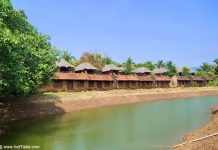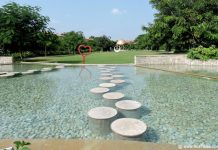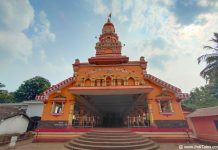After being in Goa for more than 3 years now, to me, exploration of Goa is the exploration of its lovely villages. Villages that are still rustic, villages that are affluent, and villages that are still tucked in the middle of nature. Last year when I wrote about Aldona, I got requests from some more villages to visit them. Assagao was one of them. After a long chain of email exchanges, this January I got to spend half a day in this lovely flower village of Goa.
Yes, you read it right – Assagao is known as ‘Fullyanchem Gaon‘ or the flower village. Villagers here used to grow Marigold flowers to sell in the famous Mapusa market. Mapusa is just about 4 km to the east of the village. Assagao is, in fact, Goa’s own valley of flowers – surrounded by hills all around. Even when you go from Mapusa, you climb a hill and then go down to enter the village.
You do not see many flowers now apart from the tufts of Bougainvillea in their bright colors almost everywhere.
Casa Pallotti

We were supposed to meet near Pallotti’s house in the village – which was thankfully well-marked on Google Maps. I reached a few minutes earlier than the walk time. I had time, so I walked into the premises of the Pallotti building. It turned out to be a seminary that teaches theology or philosophy and religion. The huge campus was inviting me to walk around. I walked towards the building to find the ancient Indus Valley seals replicated on the walls.

Inside the building, a lovely tree was looming large with all its branches creating an umbrella-like formation. Under another tree sat Buddha in a meditative state. A wall had Saraswati carved on it. I spoke to the father & he told me that this is where the Christian priests are taught both Indian and Western philosophy. How interesting is it to discover such things even before you have begun the official heritage walk?

We met the happy Felly and he introduced Assagao with a nice jingle that he and his team have come up with. We started walking towards the Pallotti house again. This was the Vodle Ghor or the biggest house in the village. Now, this houses a couple of institutes – one for the priests and the other for the nuns. We walked inside the residential part of it. The narrow corridor led to the dining hall where I could see some remnants of carved wood furniture. This original building was in wood. It was damaged in a fire and the reconstruction was done without much use of wood.
Houses of Assagao

Walking around Pallotti’s house would give you a feeling of how the large houses of Goa used to be. A peculiar thing I noticed was the use of wastewater to feed the plants. Something that ensures that no wastewater goes to waste. There is also a fruit orchard almost in every house here.

We walked past well-maintained houses in typical Goan architecture. Most houses have narrow main gates guarded by lions on both sides. A few steps lead to the red Balcao, shell windows in beautiful shapes, laterite wells, and slanted red roofs come together in a unique combination in each house. Even if there is no one to guide you, you can walk around admiring these houses.

We started walking towards the St Cajetan Church on the street with lovely old trees. The canals crisscrossing the village could be seen anywhere. I learned that the town was surrounded by seven springs and the waters fed the village once upon a time. The springs were supposed to have medicinal properties – each one to take care of a different medical problem.
Dovornem – The rest points

These tiny white structures by the road – I assumed they were the crosses that can be seen everywhere in Goa. I was wrong. These were meant for the traders to keep their stuff on when they stop to take a rest. If you look behind the structure, you would find a well-equipped well. So, these roads were mini trade routes. People carrying their goods on their heads would keep them here, have some water, and take some rest before moving on. Something like the pit stops on modern highways.
Many of these structures can be seen around the village. How well planned our trade routes were even if they just connected to the next big town and goods carried were mostly delicate flowers.

Felly & Valencio showed a lot of berry trees. They could recognize most of which can be eaten. I remember I had written about the Churna berry in my post on the fruits of Goa. It was here that I first saw the tree. Apparently, the village has 8-10 different varieties of berries that can be eaten. Now it would be another task to learn to identify them. If berries are there, birds can’t be too far. We would come back for birding another day. However, I did manage to catch this bird on a tree.
St Cajetan Church

Every village in Goa has a church at its center. Here it is on a small hill – a lovely church in pristine white. Actually, they always look lovely.
Now the interesting bit about the cemetery at St Cajetan Church I was told is that it has different classes of graves. Social hierarchy following you even after your death may be unique to the village.
We went inside the rectory – the house attached to the church and I saw some lovely doors. Interesting staircases led to the first floor. Here long corridors had a dash of color added to their ambiance with a few rows of stained glasses.

We entered the church from the first floor. From the top, the little church in blue looked beautiful. Now that I was on the upper floor, I could see the wooden roof more closely with stars carved on it. I wonder how it would look with some backlighting.
St Cajetan Church in the village dates back to 1776 CE. It is one of 23 churches built by the Portuguese in Bardez to spread Christianity. The church bell that was installed in 1910 CE weighs 460 kg. It was made in England, and transported to Mormugao Port in Goa. From there it was ported to Chapora from where it reached this Church.
Pillar at Assagao

A little hike on the hill opposite the St Cajetan Church will take you to a tapering Pillar standing alone among the wild trees. My guides told me that it is an ancient pillar. Probably put up as a marker by the travelers. There is no inscription. The cement work on top makes it look fairly new. But I was told that is a part of the recent restoration. Seems like a rural milestone to guide the travelers. But then there should be some more of them. The path on the hill leads to a plateau on top and then to the next villages.

On the way, we stopped at the house where the Bollywood film Finding Fanny was shot. We stopped at Felly’s home and saw his open-air Spa. As I walked back to the car, I felt I have had an intimate conversation with the village.
However, it is the lovely old trees of this lovely village that I would remember the most. That is what I would come back to the village for.
The village is home to a few designer stores, restaurants, studios, and some interesting hotels in Goa.
Thank you Assagao

I had the perfect company to take me around the village. Leading us was Felly Gomes – the founder of Live Happy NGO that operates out of the Dalgado school building. Live Happy works towards waste management and keeps the village clean. They also do the ‘Assagao Heritage Walk’ on demand. Felly was assisted by Valencio who always had all the dates and names from history. Arvind Prabhakar represented the new citizens who have recently chosen to make the village their home.
Orlando Braganza represented the people who have spent their childhood in the village and who keep coming back to the village. I must thank Orlando for all his efforts to not only invite me to the village but also coordinate everything else to make it a great experience. Orlando, I loved your backyard in the village.
See you soon at another village in Goa.















Hi Anuradha,
Nice Blog ,,,,,,,,,,, Happy Information Enjoy It
good observations and equally good jottings with the pen.
Thank you, Dr. Karthik.
Love this! I had no idea about Assagao had anything to do with flowers. I have visited it many times and have always admired the architecture. I love these airy houses with oyster shell windows. 🙂
Thank you, Sonal. Next time you are here, will take you for a village walk.
Next time I visit Goa, I will definitely explore this side of it 🙂
Tes, you must explore the villages of Goa – they are beautiful.
Pity that Assagao is being changed beyond recognition by excessive development and concretization. The quiet, quaint old village has changed its character with houses being converted into birthing spaces, yoga schools, ayurvedic treatment centres and other types of commercialization. The lovely Val spring is now thoroughly polluted and the original inhabitants are slowly being eased out.
I’m just an ethnic Goan who misses the Goa that was!
Thanks Tony for sharing your thoughts. As a recent resident of Goa, I can only share what I see, but it is you, the people of Goa who can share the changes the villages have seen.
Hi I am Deepak Beradiya from Mumbai i was there in Assagaon for 10 days such a beautiful place especially some area of opposite St.cajetan Church it’s cosy road surrounded by coconut and other trees little bit of grass it’s period was November 2016 I enjoyed a lot by walking bike riding it’s a great feel I I loves Assagaon and I love Goan all the beautiful villages like Parra, Saligaon,Aldona,Loutelime,Cortalime,I am not went for just fun but I feel it atmosphere of tree,grass, landscapes.
Feel Goa……….
Yes, Deepak. Goan villages are beautiful.
Anuradha mem thanks for reply. I am planning to go this year again it could be my third treep for GOA.
Hey Anuradha . Nice info ???? would like to see you at Goa. Wish you could help me finding sone unique and vergin locations for my small film . Regards
Sure, drop me a mail ( Id on the contact page) and let me know what kind of locations you are looking for and I will try my best to help.
Proud to be the Son of this village Assagao!!
You are blessed, Neil.
Casa Palotti was gifted to the Palatine Fathers by my husband’s Grandmother, Heremita Rodrigues. She lived there as a child. It was a large house with a ballroom and minstrel’s gallery. Our whole family went to visit several years ago – her children, grandchildren and great grandchildren. We were happy to see what good use had been made of the property and it was nostalgic for us as a family.
Great to hear your memories of Assagao Lynn.